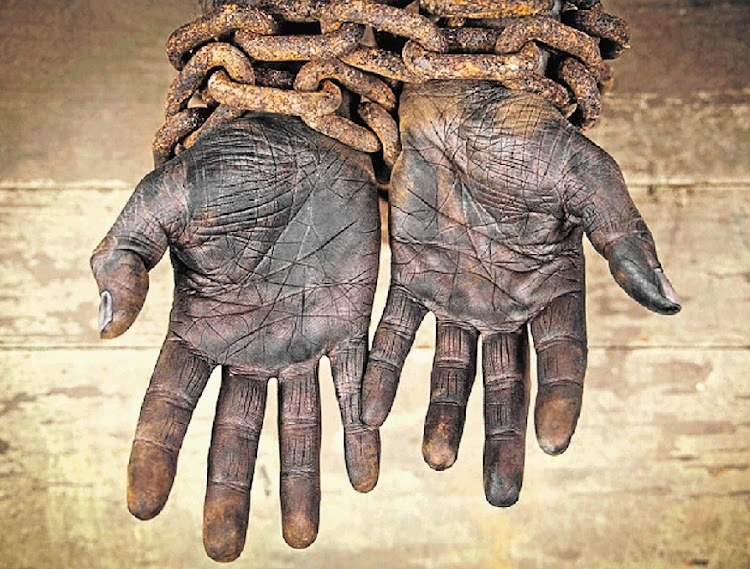
Slavery, both historical and modern, have left indelible marks on societies worldwide. From ancient civilizations to contemporary global economies, the exploitation of vulnerable individuals has persisted, albeit in evolving forms. This introduction sheds light on the multifaceted issue of slavery, exploring its historical roots, significant milestones, and ongoing challenges. Through a series of facts and figures, we delve into the complexities of this issue, highlighting the urgency of collective action to combat exploitation, protect human rights, and foster a more just and equitable world.
Ancient Practice (B.C.): Slavery has been an entrenched practice throughout human history, with evidence tracing back to around 8000 B.C. in ancient Mesopotamia, modern-day Iraq and Kuwait. This early form of slavery was integrated into the social and economic structures of the time, where slaves were typically prisoners of war, criminals, or debtors. These individuals were forced to perform various labor-intensive tasks, ranging from agricultural work to construction and domestic service. The existence of slavery in such early civilizations highlights its pervasive role in human societies, laying a grim foundation that would persist for millennia across different cultures and regions.
Transatlantic Slave Trade (Millions of Africans Enslaved): From the 16th to the 19th centuries, the transatlantic slave trade forcibly transported an estimated 12.5 million Africans to the Americas. This massive and brutal operation was part of a larger system of exploitation and commerce that saw European powers profit immensely from the sale and labor of enslaved Africans. Captured from their homelands, these individuals endured horrific conditions on overcrowded ships during the Middle Passage, leading to a high mortality rate. The survivors were then sold into slavery in various parts of the Americas, where their labor was essential to the economic development of European colonies.
Dominant European Powers: The transatlantic slave trade was dominated by European powers such as Portugal, Spain, Britain, France, and the Netherlands. These nations established extensive networks for capturing, transporting, and selling enslaved Africans. Portugal and Spain were early leaders in this trade, initiating the first transatlantic voyages in the 15th and 16th centuries. Britain and France later became prominent players, with British ships transporting the largest number of enslaved Africans by the late 18th century. The involvement of these powerful nations in the slave trade significantly impacted the social, economic, and political landscapes of the Atlantic world.
Triangle Trade Routes: The transatlantic slave trade operated on a triangular route that connected Europe, Africa, and the Americas. European merchants would load ships with manufactured goods, such as guns, textiles, and alcohol, and sail to Africa, where these goods were exchanged for enslaved people. The next leg of the journey, known as the Middle Passage, involved transporting the enslaved Africans across the Atlantic to the Americas. Upon arrival, the enslaved were sold, and the ships were loaded with raw materials like cotton, sugar, and tobacco, which were then transported back to Europe. This triangular trade system was highly profitable and integral to the economies of the participating nations.
Middle Passage Horrors: The Middle Passage was the most harrowing segment of the transatlantic slave trade. Enslaved Africans were packed tightly into the holds of ships, with little regard for their health or wellbeing. The conditions were appalling—cramped spaces, poor ventilation, rampant disease, and insufficient food and water led to high mortality rates. It is estimated that millions died during these voyages due to malnutrition, disease, and abuse. The survivors endured unimaginable suffering, marking the Middle Passage as one of the darkest chapters in human history and a stark reminder of the brutal realities of the slave trade.
Colonial Cash Crop (Percentage): Enslaved labor was crucial to the production of cash crops like cotton, tobacco, and sugar in the Americas, contributing significantly to colonial wealth. In many regions, over 50% of the colonial economy relied on the labor of enslaved people. Plantations in the Southern United States, the Caribbean, and South America were heavily dependent on this forced labor to meet the high demand for these commodities in Europe and elsewhere. The profitability of these crops fueled the expansion of slavery, as plantation owners sought to maximize their output and profits by exploiting enslaved workers.
American Revolution Paradox: The American Revolution, which championed the ideals of liberty and freedom, paradoxically did not lead to the abolition of slavery. While the revolutionaries fought for their independence from British rule, the demand for slave labor in the newly independent United States continued to grow. The economic benefits of slavery, particularly in the Southern states, were deemed too significant to relinquish. This paradox highlighted the deep-rooted contradictions within American society and laid the groundwork for future conflicts over the issue of slavery, eventually leading to the Civil War.
Underground Railroad (Miles): The Underground Railroad was a clandestine network of routes and safe houses that helped thousands of enslaved people escape to freedom in the northern states and Canada. The exact routes varied, but the total distance traveled could span hundreds, up to 1,000 miles. Conductors, including prominent figures like Harriet Tubman, guided escapees through dangerous and difficult terrain, often at great personal risk. The network’s success relied on the bravery and solidarity of those who operated it, offering hope and a path to freedom for many enslaved individuals seeking to escape the horrors of bondage.
Harriet Tubman (Nicknames, Number of Escaped Enslaved People): Harriet Tubman, one of the most famous conductors on the Underground Railroad, made nineteen missions and helped an estimated 70 enslaved people reach freedom. She earned nicknames such as “Moses” for her unwavering dedication and leadership. Tubman’s remarkable courage and strategic acumen allowed her to evade capture repeatedly, despite the dangers she faced. Her efforts not only liberated many individuals but also inspired countless others and underscored the potential for resistance against the institution of slavery.
Dred Scott Decision (Year, Court): The Dred Scott v. Sandford decision of 1857 by the U.S. Supreme Court was a landmark case that heightened tensions in the United States. The Court ruled that Black people, whether enslaved or free, were not U.S. citizens and therefore had no right to sue in federal court. This decision further entrenched the institution of slavery and denied basic legal protections to Black individuals. The ruling provoked outrage in the abolitionist movement and deepened the national divide over slavery, contributing to the mounting conflicts that eventually led to the Civil War.
13th Amendment (Year, Ratified): The 13th Amendment to the U.S. Constitution was ratified in 1865, officially abolishing slavery and involuntary servitude throughout the United States. This landmark amendment marked a significant turning point in American history, bringing an end to centuries of legalized slavery. Despite its passage, the amendment faced considerable opposition, particularly from Southern states that relied heavily on slave labor. The 13th Amendment laid the foundation for future civil rights advancements, although the struggle for equality and justice for formerly enslaved individuals and their descendants would continue for many decades.
Civil War Casualties (Soldiers): The American Civil War, fought from 1861 to 1865, was partly over the issue of slavery and resulted in the deaths of an estimated 620,000 soldiers. This conflict remains the deadliest war in American history, with casualties surpassing those of all other U.S. wars combined. The war pitted the Northern states, or the Union, against the Southern states, or the Confederacy, who sought to maintain their slave-based economy. The immense loss of life and the eventual Union victory led to the abolition of slavery and significant, though often contentious, changes in American society.
Jim Crow Laws (Era): The Jim Crow era, spanning from the late 19th century to the mid-20th century, was a period of legalized racial segregation and discrimination in the Southern United States. Following the abolition of slavery, these laws were enacted to disenfranchise and marginalize African Americans, maintaining white supremacy through systemic oppression. Jim Crow laws dictated every aspect of public and private life, from education and employment to transportation and housing. The era perpetuated racial inequalities and injustices, creating a deeply divided society that African Americans and their allies fought tirelessly to dismantle during the Civil Rights Movement.
14th Amendment (Year, Ratified): The 14th Amendment, ratified in 1868, aimed to grant citizenship to all persons born or naturalized in the United States, including former slaves. This amendment was a critical step in extending civil rights and legal protections to African Americans. It includes key provisions such as the Equal Protection Clause, which requires states to provide equal protection under the law to all people within their jurisdictions. Despite its intentions, the amendment’s promises were often undermined by discriminatory practices and Supreme Court rulings that limited its scope, necessitating ongoing efforts to achieve true equality.
15th Amendment (Year, Ratified): The 15th Amendment, ratified in 1870, prohibited states and the federal government from denying a citizen the right to vote based on “race, color, or previous condition of servitude.” This amendment sought to enfranchise African American men following the Civil War. However, despite its passage, many Southern states implemented measures such as literacy tests, poll taxes, and other discriminatory practices to circumvent the amendment and disenfranchise Black voters. The struggle for voting rights continued for nearly a century, culminating in the Voting Rights Act of 1965, which aimed to eliminate these barriers.
Sharecropping System (Post-Emancipation): Following emancipation, the sharecropping system emerged in the American South as a means to maintain the agricultural economy. Formerly enslaved individuals and poor whites would work on land owned by white landowners in exchange for a share of the crops produced. While technically free, many Black sharecroppers remained trapped in a cycle of debt and poverty due to unfair practices and exploitative contracts. Sharecropping often left workers with little to no profit after settling debts with landowners, creating conditions that closely resembled the economic dependency and hardship of slavery.
Global Abolition Movements (19th and 20th Centuries): The 19th and 20th centuries saw growing global movements for the abolition of slavery, with significant efforts in Africa, Asia, and South America. These movements were driven by a combination of moral, economic, and political factors, leading to the eventual abolition of slavery in many countries. For example, Brazil, the last country in the Americas to abolish slavery, did so in 1888. International organizations and treaties, such as the League of Nations and later the United Nations, played crucial roles in promoting anti-slavery initiatives and human rights, although illegal forms of slavery and exploitation persist in some areas.
Estimated People Still Enslaved Today (Millions): According to estimates by the International Labour Organization, over 40 million people are still enslaved worldwide today, trapped in conditions of forced labor, debt bondage, or human trafficking. Modern slavery takes many forms, including exploitation in industries such as agriculture, construction, and domestic work. Victims often come from vulnerable populations, including children, migrants, and refugees. Despite international efforts to combat these practices, modern slavery remains a pervasive and deeply troubling issue that requires continued vigilance and action from governments, organizations, and individuals.
Anti-Slavery International (Year Founded): Anti-Slavery International, founded in 1839, is one of the world’s oldest human rights organizations dedicated to ending slavery and trafficking. Originally established as the British and Foreign Anti-Slavery Society, the organization has a long history of advocating for the abolition of slavery and supporting the rights of formerly enslaved individuals. Today, it continues to work globally to address contemporary forms of slavery, including forced labor and human trafficking, through advocacy, research, and partnerships with local organizations. Anti-Slavery International’s efforts have been instrumental in raising awareness and driving legislative changes to protect vulnerable populations.
United Nations Convention Against Transnational Organized Crime (Year Adopted, Focus): The United Nations Convention Against Transnational Organized Crime, adopted in 2000, includes a protocol specifically aimed at combating trafficking in persons, especially women and children. Known as the Palermo Protocol, it sets out a comprehensive framework for international cooperation to prevent, suppress, and punish human trafficking. The protocol focuses on protecting victims, prosecuting offenders, and promoting partnerships among nations to address the root causes of trafficking. This convention represents a significant step in the global fight against modern slavery and human trafficking, providing a legal basis for coordinated action and support for affected individuals.
Human Trafficking Hotline Calls (US, Yearly): The National Human Trafficking Hotline in the United States receives over 10,000 calls per year, reflecting the persistent issue of human trafficking within the country. This hotline provides critical support to victims and survivors, offering resources, crisis intervention, and connections to local services. The high volume of calls underscores the widespread nature of human trafficking, which can include forced labor, sexual exploitation, and domestic servitude. The hotline also plays a crucial role in collecting data, raising awareness, and aiding law enforcement in identifying and prosecuting traffickers.
Vulnerable Populations: Children, refugees, and migrant workers are particularly vulnerable to human trafficking and forced labor due to their disadvantaged positions. These populations often lack the legal protections, social networks, and economic resources needed to defend against exploitation. Traffickers prey on their vulnerabilities, promising jobs, education, or safe passage, only to trap them in situations of forced labor or sexual exploitation. Addressing the needs and protection of these vulnerable groups is essential in the fight against modern slavery, requiring coordinated efforts from governments, NGOs, and international organizations.
Fast Fashion Industry (Transparency): The fast fashion industry has been criticized for its lack of transparency in supply chains, raising concerns about the potential use of forced labor in garment production. Brands often outsource manufacturing to countries with lower labor costs, where regulations may be weak or poorly enforced. This opacity can hide exploitative practices, including forced labor and poor working conditions. Consumers and advocacy groups are increasingly demanding greater transparency and accountability from fashion brands to ensure ethical sourcing and fair labor practices, promoting initiatives like sustainable fashion and ethical certification.
Technology’s Role (Combatting and Enabling): Technology plays a dual role in the context of modern slavery, both as a tool for combating and enabling trafficking. On the one hand, technological advances such as data analytics, blockchain, and mobile apps help track and report human trafficking, enhance victim support services, and improve law enforcement capabilities. On the other hand, traffickers exploit technology to recruit, exploit, and control victims through online platforms, encrypted communications, and fraudulent job advertisements. Balancing the benefits and risks of technology is crucial in the ongoing fight against human trafficking and forced labor.
United Nations Convention Against Transnational Organized Crime (Year Adopted, Focus): Adopted in 2000, the United Nations Convention Against Transnational Organized Crime includes a protocol specifically aimed at combating trafficking in persons, especially women and children. This protocol, known as the Palermo Protocol, provides a comprehensive framework for international cooperation to prevent, suppress, and punish human trafficking. It emphasizes the protection of victims, the prosecution of traffickers, and the promotion of partnerships among nations to tackle the root causes of trafficking. The convention represents a significant international commitment to addressing and mitigating the impacts of human trafficking on a global scale.
5 FAQs About Slavery:
What are the different forms that slavery has taken throughout history?
Slavery has existed for millennia and has taken many forms across different cultures. Here are some key types:
Chattel Slavery: This is the most well-known form, where enslaved people are considered property to be bought, sold, and inherited. This was prominent in the transatlantic slave trade and the American South.
Debt Bondage: People are forced to work to repay a debt, often passed down through generations, making escape nearly impossible.
Domestic Servitude: Enslaved people work in private households, performing domestic chores and caring for children.
State Slavery: Enslaved people are owned and controlled by the government, often used for public works projects or military service.
What caused the rise of the transatlantic slave trade?
The transatlantic slave trade emerged in the 15th and 16th centuries due to a confluence of factors:
European Expansion: European powers sought wealth and resources through colonialism in the Americas.
Demand for Labor: Cash crops like cotton, tobacco, and sugar required a large and cheap workforce to be profitable.
Pre-existing Slavery in Africa: Slavery already existed in some African societies, which European traders exploited to capture and transport enslaved people.
Technological Advancements: Improvements in shipbuilding and navigation allowed for faster and more efficient transatlantic voyages.
What was the impact of slavery on the Americas?
Slavery had a profound impact on the Americas, shaping economies, societies, and cultures:
Economic Engine: Slave labor fueled the production of cash crops, generating immense wealth for plantation owners and contributing significantly to colonial economies.
Social Hierarchy: Slavery created a rigid social hierarchy with white slaveholders at the top and enslaved people at the bottom. Racial prejudice and discrimination became deeply entrenched.
Cultural Exchange: Despite forced separation, enslaved Africans brought their traditions, music, and cuisine to the Americas, influencing cultural development.
How was slavery finally abolished in the United States?
The abolition of slavery in the United States was a long and complex process:
Abolitionist Movement: Throughout the 19th century, a growing abolitionist movement campaigned against slavery, highlighting its moral injustice and economic inefficiency.
Tensions and Civil War: The issue of slavery divided the nation, culminating in the American Civil War (1861-1865), where the North fought to preserve the Union and abolish slavery, while the South fought to maintain its slave-based economy.
13th Amendment (1865): The war’s outcome led to the ratification of the 13th Amendment in 1865, officially abolishing slavery and involuntary servitude throughout the United States.
Does slavery still exist today?
Sadly, slavery continues in various forms around the world today, despite its official abolition. Here’s a glimpse into the grim reality:
Forced Labor: Millions of people are trapped in forced labor, working under threat, coercion, or debt bondage in industries like agriculture, construction, and domestic service.
Human Trafficking: Traffickers exploit people for forced labor, sexual exploitation, or organ harvesting.
Modern Day Slavery: These terms encompass various forms of exploitation, including child soldiers, forced marriage, and debt bondage.
Combating modern slavery requires international cooperation, law enforcement efforts, and support for vulnerable populations.








